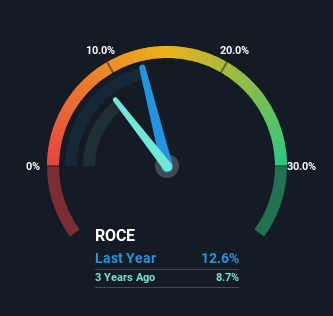
If you're looking for a multi-bagger, there's a few things to keep an eye out for. Ideally, a business will show two trends; firstly a growing return on capital employed (ROCE) and secondly, an increasing amount of capital employed. Put simply, these types of businesses are compounding machines, meaning they are continually reinvesting their earnings at ever-higher rates of return. Having said that, from a first glance at Pokarna (NSE:POKARNA) we aren't jumping out of our chairs at how returns are trending, but let's have a deeper look.
Return On Capital Employed (ROCE): What Is It?
For those who don't know, ROCE is a measure of a company's yearly pre-tax profit (its return), relative to the capital employed in the business. The formula for this calculation on Pokarna is:
Return on Capital Employed = Earnings Before Interest and Tax (EBIT) ÷ (Total Assets - Current Liabilities)
0.13 = ₹1.1b ÷ (₹11b - ₹2.2b) (Based on the trailing twelve months to June 2023).
So, Pokarna has an ROCE of 13%. On its own, that's a standard return, however it's much better than the 6.7% generated by the Basic Materials industry.
View our latest analysis for Pokarna

Historical performance is a great place to start when researching a stock so above you can see the gauge for Pokarna's ROCE against it's prior returns. If you want to delve into the historical earnings, revenue and cash flow of Pokarna, check out these free graphs here.
What The Trend Of ROCE Can Tell Us
When we looked at the ROCE trend at Pokarna, we didn't gain much confidence. Around five years ago the returns on capital were 22%, but since then they've fallen to 13%. And considering revenue has dropped while employing more capital, we'd be cautious. If this were to continue, you might be looking at a company that is trying to reinvest for growth but is actually losing market share since sales haven't increased.
In Conclusion...
From the above analysis, we find it rather worrisome that returns on capital and sales for Pokarna have fallen, meanwhile the business is employing more capital than it was five years ago. Yet despite these poor fundamentals, the stock has gained a huge 296% over the last five years, so investors appear very optimistic. In any case, the current underlying trends don't bode well for long term performance so unless they reverse, we'd start looking elsewhere.
If you'd like to know more about Pokarna, we've spotted 4 warning signs, and 2 of them are significant.
For those who like to invest in solid companies, check out this free list of companies with solid balance sheets and high returns on equity.
New: Manage All Your Stock Portfolios in One Place
We've created the ultimate portfolio companion for stock investors, and it's free.
• Connect an unlimited number of Portfolios and see your total in one currency
• Be alerted to new Warning Signs or Risks via email or mobile
• Track the Fair Value of your stocks
Have feedback on this article? Concerned about the content? Get in touch with us directly. Alternatively, email editorial-team (at) simplywallst.com.
This article by Simply Wall St is general in nature. We provide commentary based on historical data and analyst forecasts only using an unbiased methodology and our articles are not intended to be financial advice. It does not constitute a recommendation to buy or sell any stock, and does not take account of your objectives, or your financial situation. We aim to bring you long-term focused analysis driven by fundamental data. Note that our analysis may not factor in the latest price-sensitive company announcements or qualitative material. Simply Wall St has no position in any stocks mentioned.
About NSEI:POKARNA
Pokarna
Engages in quarrying, manufacture, processing, and sale of granites in India.
Outstanding track record with excellent balance sheet.
Similar Companies
Market Insights
Community Narratives




